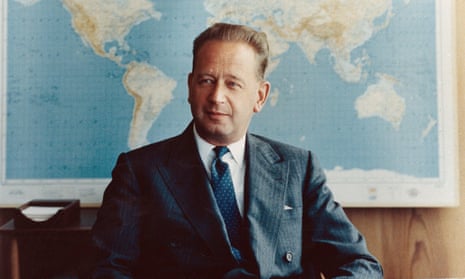What caused the 1961 plane crash that killed former UN secretary general Dag Hammarskjöld? A Swedish-led UN inquiry the following year concluded that the plane, the Albertina, had crashed in northern Rhodesia (now Zambia) as a result of “pilot error”. But this failed to satisfy many who have long suspected foul play.
There were claims that the Albertina, which was carrying Hammarskjöld and a 15-strong team seeking to negotiate a ceasefire in the breakaway African republic of Katanga, was riddled with bullets. Several witnesses said they saw as many as eight white men, armed and in combat fatigues, at the crash site.
An industrialist in the copper belt of the old northern Rhodesia apparently saw convoys of Land Rovers heading into the bush after the crash.
Even the former US president Harry Truman was suspicious. The day after the crash he told reporters that Hammarskjöld was at “the point of getting something done when they killed him. Notice that I said ‘when they killed him’.”
Now, more than 50 years on, the UN is poised to accept that the findings of its original inquiry could be wrong. In a historic move, the UN general assembly will pass a resolution this Tuesday reaffirming its “responsibility to pursue the full truth concerning the conditions and circumstances resulting in the tragic death of Dag Hammarskjöld and of the members of the party accompanying him”.
The resolution recognises “that a further inquiry or investigation would be necessary to finally establish the facts of the matter” and requests that the secretary general “appoint an eminent person to review the potential new information, including that which may be available from member states, to assess its probative value and to determine the scope that any further inquiry or investigation should take”.

The eminent person will have their work cut out. Few who have studied the crash will be confident that anyone can ever know what really happened. But a plausible theory is starting to emerge.
A report from a panel of distinguished international jurists, commissioned by the Hammarskjöld Inquiry Trust chaired by Lord Lea of Crondall and submitted to the UN last year, heard suggestions “that a group representing a number of European political and business interests ... wanted the secretary general’s plane diverted from Ndola [city in Zambia] ... in order to persuade him of the case for Katanga’s continued independence”.
The group feared what would happen to their mining concessions if Katanga was reabsorbed into Soviet-backed Congo.
There has been speculation that in the attempt to force the plane to land, the Albertina was either mistakenly strafed with bullets or disorientated by lights from another plane, which caused it to crash.
Lea said: “With the likely adoption of this new Swedish resolution sponsored by 56 countries, the UN position is patently shifting from what in the language of the Swedish inquiry in 1962 had been unequivocally ‘pilot error’ to what in a coroner’s court in the UK would be termed an ‘open verdict’. This will be pursued further by the new and more focused remit to be given to the new UN investigator to throw a further spotlight on key areas of emerging new evidence.”
The UN resolution urges “all member states to release any relevant records in their possession” and “to ensure that any relevant records related to the death of Dag Hammarskjöld and of the members of the party accompanying him that remain classified, more than 50 years after the fact, are declassified or otherwise made available for review.”
This is potentially significant. It is believed that the US National Security Agency (NSA) may be in possession of crucial radio intercepts taken from pilots who were in the area at the time the Albertina came down.
- This article was amended on 4 December 2016 to make clear that Harry Truman was no longer the US president when Hammarskjöld died.








